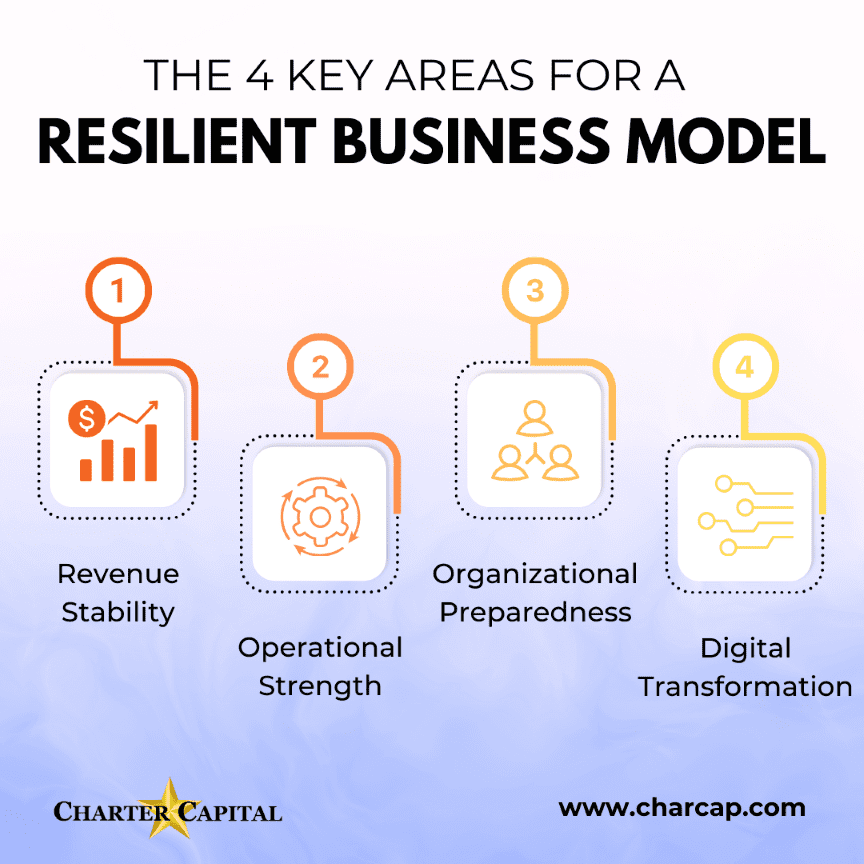
Developing a resilient business model is essential when you’re trying to future-proof your company. This page will walk you through the basics, including what resilience means in a business sense, what to look for if you perform an audit, and areas to address as you refine your business model for greater resiliency.
What is Business Resilience?
More than a half million small businesses fail annually, the Chamber of Commerce reports. This is under normal circumstances and doesn’t consider market fluctuations or enduring challenges like pandemics. Conversely, resilient businesses are more likely to thrive. They prepare for, adapt to, and respond to changes quickly.
Traits of a Resilient Business Model
Before we get into how to create a resilient business model, let’s explore what one looks like.
- The company anticipates changes to the operating environment.
- The company develops and tests plans that will help it navigate those changes.
- The company allocates resources and enables success in multiple potential futures.
Business Resilience vs. Enterprise Risk Management
Business resilience is often treated as a synonym for risk management. While risk management is part of a resilient business strategy, a resilient business doesn’t just mitigate risk. It finds the upside in challenging situations, too.
Business Resilience vs. Business Continuity
Sometimes, business resilience and continuity are considered the same as well. Continuity is more about ensuring your business operations aren’t impacted during a crisis or that it bounces back quickly if an outage cannot be prevented. Continuity is built into a resilient business model. However, a resilient business also adapts to changing times and needs. It’s concerned with how the business will operate in multiple potential futures, not just getting back on track if a roadblock appears in one intended future.
How to Measure Resilience of a Business Model
It’s a good idea to audit your current business model before you make changes and to test out how any changes you make impact your business. You can use metrics in the following areas to tell if your model is successful and identify areas of opportunity.
Risk Management
Is your company identifying and addressing risks, or are things slipping through the cracks until you hit a crisis point?
Response Time
How long does it take your company to recognize when it has a problem and begin trying to solve it? Consider a variety of situations, from security threats to natural disasters.
Recovery Time
How quickly does your team solve problems? Are you losing time to disorganization, a lack of resources, or other issues?
Adaptability
Can company leadership pivot as needed, when a crisis arises, or as customer needs change?
Financial Stability
Is your cash flow stable? Do you have solutions in place that can help if you face a cash flow disruption?
4 Keys Areas Your Resilient Business Model Must Address
Now that we’ve reviewed the background, let’s explore what to cover as you develop a more resilient business model.
1. Revenue Stability and Recovery
Businesses with one or two revenue streams are more vulnerable to change. Identify new ways your company can generate revenue or stabilize it, such as adding new products or services or developing subscription-based options.
Also, determine how your business will obtain cash if revenue is impacted. While loans can work for some well-established businesses, not everyone qualifies, they can take weeks or months to pay out, and tend to dry up in times of economic uncertainty. An alternative like invoice factoring may be ideal because you can become established with a factoring company and not factor invoices until you need to. This provides flexibility and fast payments while allowing you to maintain greater control over costs.
2. Operational Strength
Redundancy and diversity are central themes when developing a resilient business model, especially regarding business operations.
Supply Chain
All businesses will deal with supply chain disruption at some point. While most tips center around having multiple suppliers to avoid issues, a resilient strategy also addresses how the business can manage with fewer supplies or without certain supplies.
Cost Transparency
Move to digital recordkeeping for expenses so it’s easier to budget and allocate resources effectively.
Workforce
Brands that leverage modern approaches, such as building a remote workforce and leveraging automation, work more efficiently and can often pivot more easily.
3. Organizational Preparedness
Mindsets and the structure of your teams may need to be adjusted for greater resilience, too.
Empowered Leadership
Change starts from the top and works its way down. Ensure leadership is on board with changes and understands that shifts for greater resilience are a way to future-proof the company.
It’s also imperative to ensure that leaders have the ability to make decisions as needed, as well as the training to make effective ones. Businesses that sometimes stall out during decision-making may consider implementing the 40/70 rule. It essentially states that leaders should have at least 40 percent of the information needed to make a decision but no more than 70 percent. That way, the organization doesn’t make poor decisions based on gut feelings or face “paralysis by analysis.”
Upskilling and Reskilling
It’s easier to learn new business skills than most people think. Consider implementing upskilling and reskilling programs to help your team become more resilient and agile. Upskilling centers on providing employees with skills to help them perform their current jobs better or more efficiently, so it’s an excellent way to strengthen your workforce and prime employees for advanced roles. It also boosts morale. Reskilling involves teaching employees how to perform new jobs. This is also a boon for morale, but more importantly, it allows you to keep valuable team members and shift roles as needed.
Teams
Many companies are shifting to smaller multidisciplinary teams rather than operating in large, siloed departments. This breaks down barriers, boosts collaboration, and improves agility.
4. Digital Transformation
Moving the needle on your digital transformation is crucial to building a more resilient business.
Modernization
Explore new technology to help your team work more efficiently or produce better results.
Maximization
Review your current technology to ensure you’re leveraging it to the fullest extent and maximizing the benefits.
Data and AI
Identify ways data and AI can help you make more informed decisions or automate processes.
Customer Needs
Invest in technology that can help you identify and meet changing customer needs.
Boost Your Business Resilience with Invoice Factoring
Whether you want to ensure your business will have working capital if it faces an unexpected event later or you’d like to invest in resilience initiatives now but need cash to do so, invoice factoring can help. To learn more or get started, request a complimentary factoring quote.

- Top 6 Business Growth Resources for Savvy Entrepreneurs - September 30, 2024
- 7 Essential Ways to Invest in Your Small Business - September 3, 2024
- 6 Common Bookkeeping Mistakes to Avoid - August 5, 2024

